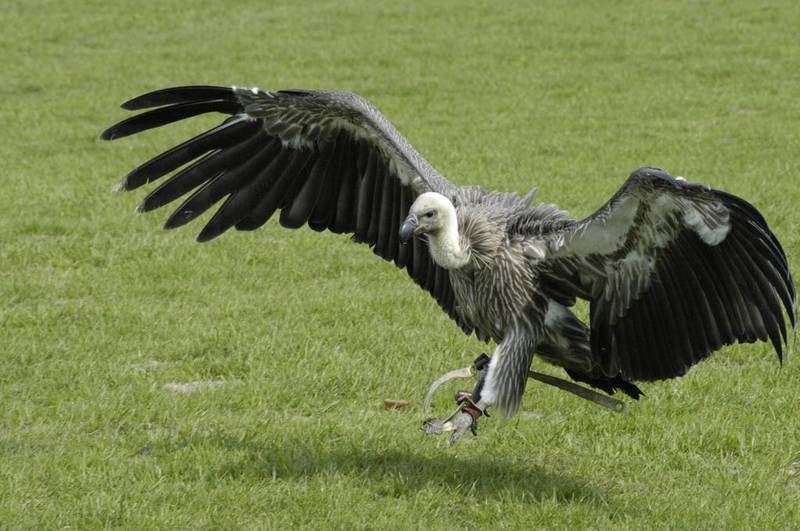| New Photos | Animal News | Animal Sounds | Animal Movies | Upload Photo | Copyright | Korean |
|---|
| Funny Animal Photos | Monsters in Animalia | Wiki Articles Fun Facts about Animals | Links | Home | Mobile A.P.A. |
|---|
| Image Info | Original File Name: Eurasian Griffon Vulture (Gyps fulvus) 2.jpg Resolution: 1024x680 File Size: 98710 Bytes Upload Time: 2007:10:28 19:13:07 | |
| Author | Name (E-mail): Unknown | |
| Subject | Eurasian Griffon Vulture (Gyps fulvus) - Wiki | |
 |
| Email : E-Card | Poster | Web Master Delete Edit Info Admin |
| Description | Eurasian Griffon Vulture (Gyps fulvus) - Wiki
Griffon Vulture
The Griffon Vulture, Gyps fulvus is an Old World vulture in the bird of prey family Accipitridae. The Griffon Vulture is 95-110 cm (37-43 in) long with a 230-265 cm (91-105 in) wingspan, and it weighs between 6 and 13 kg (13.2 and 29 lb). It is a typical Old World vulture in appearance, with a white bald head, very broad wings and a short tail. It has a white neck ruff and yellow bill. The buff body and wing coverts contrast with the dark flight feathers. Like other vultures it is a scavenger, feeding mostly from carcasses of dead animals which it finds by soaring over open areas, often moving in flocks. It grunts and hisses at roosts or when feeding on carrion. It breeds on crags in mountains in southern Europe, north Africa, and Asia, laying one egg. Griffon Vultures may form loose colonies. The population is mostly resident. R??ppell's Griffon R??ppell's Griffon is the highest flying bird on record, once spotted at an altitude of over 10,000 m (33,000 feet) in the skies of West Africa. From a standing start the R??ppell's vulture can fly over three miles in six minutes. They can cruise at over 35 km/h (22 mph), and will fly as far as 150 km (90 mi) from a nest site to find food. When thermal currents start to develop enough lift, about two hours after sunrise, R??ppell's vultures leave the roost and begin to patrol over the plains, using their exceptionally keen eyesight to find large animal carcasses, or carnivores which have made a kill. The R??ppell's vulture often stays in the air for six to seven hours a day. Status in Europe In Italy, the species survived only in Sardinia, but was re-introduced in a few other areas of the peninsula. As a result, several specimens been spotted again in August 2006 on the Gran Sasso massif (central Italy). A colony of Griffon Vultures can also be found near the town of Beli on the island of Cres in Croatia. On Cyprus, there is a colony at Akrotiri, at the south of the island. Colonies of Griffon Vultures can be found in northern Israel, especially at the Golan heights where a large colony breeds at Gamla, and at Mount Carmel, where they were repeatedly re-introduced from captivity. In Greece, there are nearly 1000 birds. On Crete they can be found on the slopes of Mount Ida. Griffon Vultures have been re-introduced successfully into the Massif Central in France; about 500 animals are now found there. In Belgium and the Netherlands, around 100 birds were present in the summer of 2007. These were vagrants from the Pyrenees population (see below). In Germany, the species died out in the mid-18th century. Some 200 vagrant birds, probably from the Pyrenees, were sighted in 2006, and several dozen of the vagrants sighted in Belgium the following year crossed into Germany in search for food. There are plans to reintroduce the species in the Alps. In Switzerland, there is a population of several dozen birds. In Austria, there is a remnant population around Salzburg Zoo, and vagrants from the Balkans are often seen. In Spain, there are tens of thousands of birds, from a low of a few 1000 around 1980. The Pyrenees population has apparently been affected by an EC ruling that due to danger of BSE transmission, no carcasses must be left on the fields for the time being. This has critically lowered food availability, and consequently, carrying capacity. Although the Griffon Vulture does not normally attack larger living prey, there are reports of Spanish Griffon Vultures killing weak, young or unhealthy living animals as they do not find enough carrion to eat. http://en.wikipedia.org/wiki/Griffon_Vulture
| |||
| Copyright Info | AnimmalPicturesArchive.com does not have the copyright for this image. This photograph or artwork is copyright by the photographer or the original artist. If you are to use this photograph, please contact the copyright owner or the poster. |
|
|
|
| |||||||
| CopyLeft © since 1995, Animal Pictures Archive. All rights may be reserved. | ||||||||
Stats